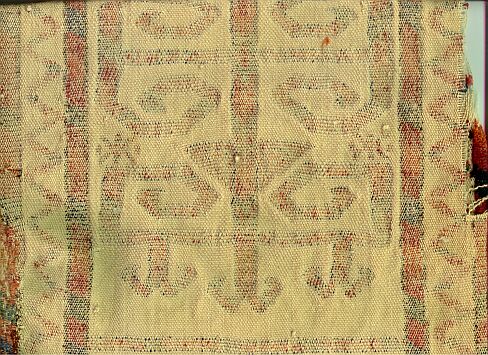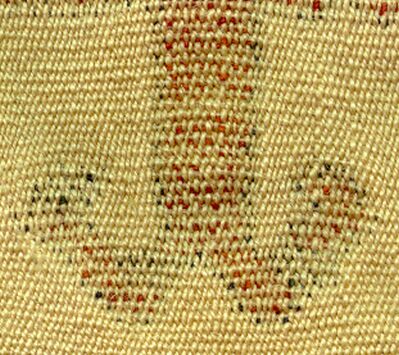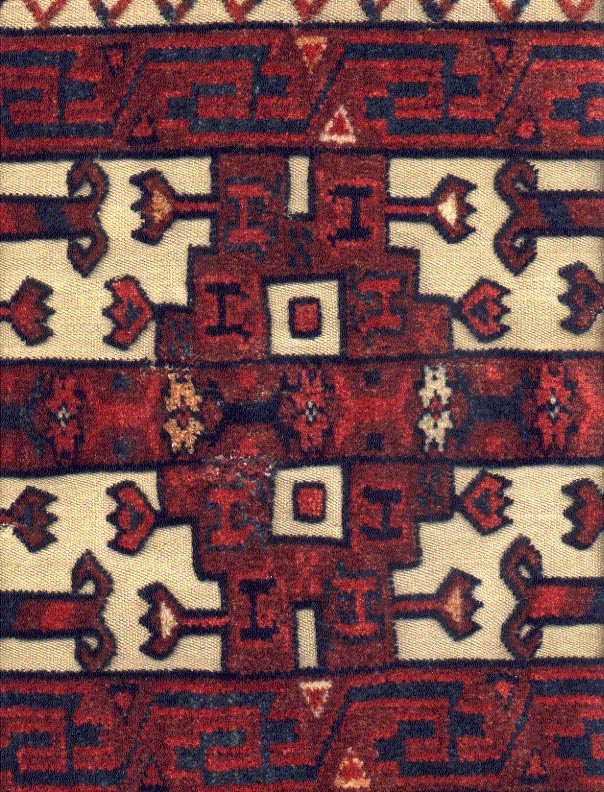Posted by R. John Howe on 06-24-2003 11:30 PM:
One Advantage of Fragments Demonstrated
Dear folks -
As is happens, I also own a Turkmen tentband in mixed
technique.
It is a short fragment that I purchased at ICOC X. One
advantage of collecting on a budget is that while Steve has had to use 19 mere
photographic images to show you his daunting piece, I can unveil mine in its
entirety using only three direct scans. 
Here they are:



This fragment is 12 inches
wide and 19 inches long (using the rule "narrower is older" mine is likely
younger). It is also entirely in wool and I do not see any silk.
Toward
one end some of the pile sections include a green that is quite bright in one
edge stripe in the upper left corner of the second image above (indicating color
here is not accurate despite the direct scan) but darker in other instances in
the same area.
Here are two images of the back:


I have begun to examine some
of the steeper angle sections for signs of the asymmetry in drawing that Marla
mentions.
(Before I go further I should acknowldege that Marla has
worked closely with Christoph Huber on this tentband analysis and the
wonderfully clear "bead" diagrams provided in the expostion on Marla's site have
been created by Christoph.)
If you have looked you have seen that Marla
says in part:
"...The important characteristic that separates extra
offset knotting from all other weaving structures used by western and central
Asian tribal weavers is its natural asymmetry."
"...The small flower
heads below were made with pile arranged diagonally as in diagram C. The shapes
are slightly asymmetrical: The diagonal outline on the left side of each blossom
is a little steeper than that on its right, and the left side has smaller
"steps" than the right. It is a quintessential tent band motif -- its
characteristics determined by the unique structure. The slant of the stems is
the same as that on the right side of the blossoms; their direction is just
reversed.

Extra
offset knotting.
Knotted pile is aligned
in consistent
diagonal
columns."
I am not sure but I think I see indications that this piece of
mine may have a lot of extra offset knotting. I think I see the "diagnonal
columns" Marla points to.
I have also tried to compare the zig zags in
the border with the two images she provides at one point to see if I can tell
whether mine might be of the two distinct weave strategies for which she
provides examples.
Here's Marla again:
"...In other words, the
Yomut weaver treated the zigzagging form as a separate element, to be
articulated in the easiest and smoothest way. The weaver of the band on the
right treated the zigzags and vertical borders as one motif, executing all parts
in the same fashion, even though on an open ground the irregular diagonal knot
alignment was a little more clumsy."
Here are the two example images
Marla provides:

Yomut (?) band with
zigzag motif articulated with the extra offsets of
diagonal knotting

Tekke
(?) band with zigzag motif articulated along with vertical borders in regular
knotting
This is probably too crude, but I wondered whether the
comparative steepness of the angle in my own piece might not hint that it is
done in the mode of her Tekke(?) example here in this area.
I'm not sure
how close this analysis at this stage places us to being able to make tribal
attributions of mixed technique tentbands, but it's encouraging. Marla does say
at one point:
"...My unsubstantiated hunch is that band techniques
employing extra offsets at least originated within Saryk or Yomut groups --
among weavers who frequently used offset symmetrical knotting in their chuvals
and rugs. "
And at the very end she talks about her analysis of one piece
and then mentions some additional indicators:
"...The fragment above (ed.
see the link) presents the typical kind of dilemma faced when we search for
tribal tent band labels. Is it Tekke? Or Yomut? A combination of clues suggests
that this example instead be tentatively labeled Saryk. First, the inclusion of
both silk and cotton pile is consistent with that attribution. So is the
fineness of the knotting, much of it done with wool singles, rather than two
singles. Bands that surely must be Yomut have lower warp counts, even when
executed with great finesse. The coral colors in this band are more typical of
Saryk work than the other groups. And included is a fine multi-ply commercial
yarn in cherry red that I have found in early Salor, Saryk and Tekke work, but
not in Yomut weavings.
"But the clinchers came in unexpected technical
details that my friend Allan Arthur noticed. Tiny colored (red and blue) weft
inlays were used to straighten and strengthen the weave near the edges --
features not found in Tekke or Yomut work, but common in Saryk weaving.
Weft-splice ridges typical of Tekke and Saryk weavings are sprinkled throughout.
Then we found overlapped knots forming columns in the outside borders -- knots
jammed together purely to add bulk and strengthen the band edges. This is a
Saryk weaving practice, and one not used in Tekke work.
"If a
significant number of bands can be attributed with some certainty based on
distinctive weaving practices and characteristics, we may then be able to add
unique extra offset knotting techniques to our arsenals of features useful for
making tent band attributions."
I think that this is wonderfully good
work and will ultimately let us sort some of these things
out.
Regards,
R. John Howe
Posted by Marvin Amstey on 06-26-2003 02:11 PM:
Another fragment
Here is a view of a fragment I own showing clear Tauk Nauska figures. These,
the colors and other designs point to Yomud for me. 
Posted by Steve Price on 06-26-2003 02:56 PM:
Hi Marvin
It's kind of interesting to find devices that are associated
with particular motifs being used "out of context" in tentbands. Your Tauk
Noskas are a nice example of this.
Panel 6 in mine also has an "out
of context" device in it -

The two little
rectangular devices are within the major motifs in this panel. Similar devices
are fairly common in the centers of octagons on Belouch bags, and can be found
from time to time within some Turkmen guls.
Regards,
Steve
Price
Posted by Patrick Weiler on 07-01-2003 02:23 PM:
John,
Your post is a bit confusing. Are the top five photos from your
tent band and the rest from Marla's site?
You mention asymmetry. I
certainly see asymmetries in the designs of the small motifs in your tent band.
One might almost describe it as clumsiness in articulation of the motifs. 
Is this from offset knotting? The
photos are not close enough to tell.
You also say that your fragment is
of mixed technique. I only see one technique, pile weave. I suspect that the
"mixed" technique that is often referred to when describing tentbands is the
pile weave on the main body of the band and a sumak or other extra-weft design
at the ends. The areas with no pile on your tentband are only the same
sub-structure that continues under the pile areas, too, so this would not be
described as a different/mixed technique (technically).

Patrick Weiler
Posted by R. John Howe on 07-01-2003 04:45 PM:
Hi Patrick -
Yes, the first five images are direct scans of my own
fragment and the other images in the first post are from Marla's site. I have
also quoted selected parts of her text.
It is likely that I mangled her
explanation somewhat in the process, so it would probably be better to go back
to the direct link I gave in another thread in this salon and read it directly
and entirely. Here it is again:
http://www.marlamallett.com/bands.htm
I probably should
not attempt to improve on Marla's explanation of both the "asymmetries" in such
weavings, or of her explanation of the character of the "offset knotting" in
such bands. I think you can likely see some indications that there are offsets
in the fifth image of mine, but maybe not.
I think my fragment is likely
from a tent band of this group that is in fact later and cruder in drawing and
that contains less rich materials than does one of the calibre that Steve has
presented. But what do you want for $150?  (I know where there is a complete
contemporary Turkmen tent band of mixed technique done entirely in silk for
which the owner is asking $12.5K, but I was a little short the last time I
visited that shop.)
(I know where there is a complete
contemporary Turkmen tent band of mixed technique done entirely in silk for
which the owner is asking $12.5K, but I was a little short the last time I
visited that shop.)
I have adopted the term "mixed technique," which I
think Marla and Christoph use too, to refer to the fact that there are pile
decorations on some areas but other areas are flatwoven (usually the white
ones).
Steve has opted for "pile decorated tent bands" to describe this
sort of tentband, but that seems to me not to distinguish the ones that are
entirely decorated with pile from those that are only partly so decorated. (Not
a heavy point; just an explanation of my usage.)
I agree that the areas
without pile have the same foundation structure as those with it, but we
frequently distinguish "pile" areas from "kilm" areas (using that latter term to
refer to nearly any flatwoven area) when we talk about rugs, so I don't think
that my usage here is at all novel.
But I think most of the confusion
will clear up if you read Marla and Christoph
directly.
Regards,
R. John Howe
Posted by Ed_Berger on 07-06-2003 06:42 PM:
Dear Steve
The "out of context device" in your tentband is just an
aina gul. Since the aina gul is exclusive to the Tekke tribe, it positively
identifies your tentband as being Tekke.
Ed Berger
Posted by Steve Price on 07-06-2003 07:40 PM:
Hi Ed
I read your message and became pretty excited. It would be more
than just a bit cool to own the only Turkmen pile decorated tentband in the
world for which a tribal attribution is unambiguous. Sadly, there are some
problems.
The first is that although there are several variations of the
aina gul, this isn't quite the same as any of them. This could easily be
rationalized, of course - it would be almost impossible for any weaver to
reproduce an aina gul accurately on the tiny scale of this device. So if
we had some independent reason for believing that this is an aina gul, we
could easily explain the fact that it lacks some of the details. Unfortunately,
I know of no argument that would lead me to conclude that this must be an
aina gul derivative.
The second problem is that even if we take
the position that this cannot be anything except an aina gul, this is not
an exclusively Tekke motif. Plate 12 in Mackie and Thompson's Turkmen is
a rather early Salor torba or trapping with a field of aina guls.
Thompson's comments on it include recognition that this is a fairly common motif
on Tekke bags, but he believes that the Tekke adopted it from the Salor. Whether
his conjecture is correct or not isn't directly relevant to us, of
course.
So, to bring a long story to a little summary,
1. It isn't
clear that this device is actually an aina gul or a derivative of one,
although that is a reasonable suspicion.
2. Even if it is an aina gul,
that wouldn't prove that it is Tekke - it could be Salor.
My opinion, by
the way, is that it is most likely to be Tekke, because Salor and Saryk weavings
are so much less common than those of the Tekke.
Thanks for the
stimulating post, and welcome to Turkotek.
Regards,
Steve
Price
Posted by Ed_Berger on 07-07-2003 06:54 AM:
Dear Steve
I have to agree that the motif that looks a lot like an
aina gul might not really be one (it probably is, I think). I didn't know about
the Salor using it, too, though. Have to check my sources better.
Thank
you,
Ed Berger












